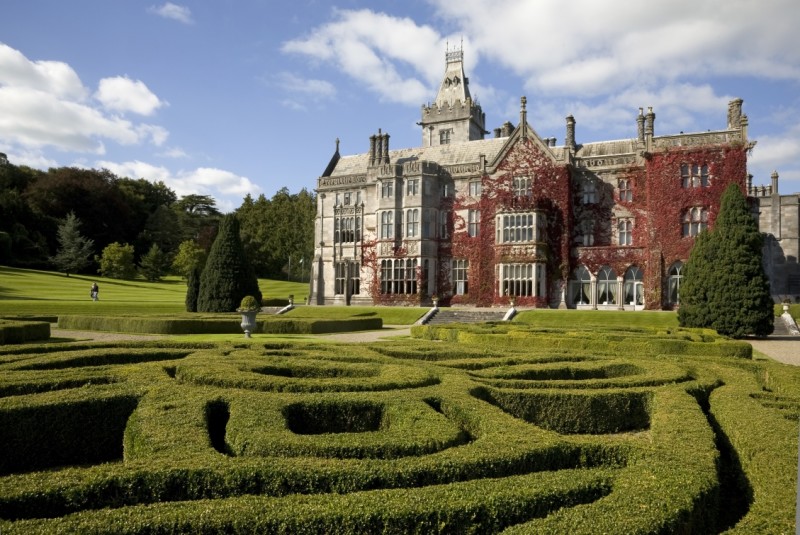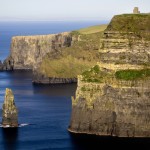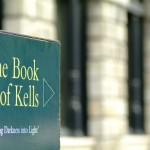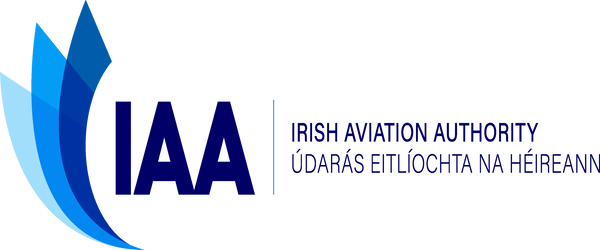This relaxing Irish Elegance tour stays at luxurious castles , hotels & manor houses.
This 5-Star Irish Elegance tour spends two nights each in Ireland’s most iconic castle, an elegant Dublin hotel, and an exquisite manor house. Begin your tour with two luxurious nights in Dublin, and then head west. Experience the scenic wonders of Connemara and the magnificent Ashford Castle. You’ll finish in grand style at Dromoland Castle, the ancestral home of the O’Briens of Dromoland, whose lineage dates back 1,000 years to Brian Boru, one of the last High Kings of Ireland!
Overnight Locations:
Night 1 & 2 – Merrion Hotel or Shelbourne Hotel, Dublin
Night 3 & 4 – Ashford Castle, Mayo
Night 5& 6 – Dromoland Castle, Newmarket on Fergus, Co. Clare.

| Low Season | Price Per person |
| Bed & Breakfast for 6 nights and Rental of an Economy Manual car | €1,738 pps |
| High Season | Price Per person |
| Bed & Breakfast for 6 nights and Rental of an Economy Manual car | €2,407 pps |
*pps=per person sharing
Tour package Includes :
- Economy Manual vehicle eg., Ford Fiesta with unlimited mileage based on a minimum of 2 people travelling together Inclusive of : Collision Damage Waiver (CDW), theft protection (TP), government tax (VAT) and Location Service Charge.(Upgrade rates for larger or automatic transmissions are available on request)
- Full breakfast daily except on day one
- All local taxes and hotel service charges
- Confirmation documents for each of your accommodations including driving directions
- All rates above are per adult sharing, child and single supplements apply
- Low Season- November-March
- High Season- April-October
Day 1 – Arrival Dublin, Ireland’s Capital City
Dublin is one of Europe’s oldest cities, retaining its historical and cultural charm. It also offers trendy bars, elegant restaurants, cosmopolitan shops and hotels.
Dublin city centre is a compact area, with all points of interest being easily accessible on foot or you could avail of the Dublin Hop on Hop Off Bus. This is an excellent way of visiting many of Dublin’s most historic locations .The all day ticket means you can hop on and off as often as you wish throughout the day allowing you explore the history and culture of Dublin at your leisure. Make sure you visit Trinity College and the Book of Kells , St. Patricks Cathedral, Christ Church/Dublinia & Guinness Storehouse at St. James Gate.
This evening, why not spend some time in the Temple Bar area. This small area boasts a dazzling choice of restaurants, cafes, bars and shops to suit all tastes and pockets, all within easy walking distance of Temple Bar’s many cultural centres and galleries. Its narrow cobbled streets are pedestrianised and are ideally suited to a leisurely stroll through the quarter.
Overnight in Dublin.
Day 2 – Dublin City Highlights
Today continue your sightseeing in Dublin as there is an abundance of wonderful visitor attractions to discover – from the most majestic museums to more modern centres of entertainment. Of course, you may wish to take time out to shop in Grafton Street or any one of a number of narrow and quaint streets that the café strewn city centre has to offer. Sit, have a coffee (or an Irish Coffee !) and watch the goings on of this bustling city.
Overnight in Dublin
Day 3 –Mayo
Just north of Dublin, you will find Ireland’s most visited attraction, the megalithic tombs in Newgrange. One of the great wonders of the ancient world, Newgrange is older than Stonehenge, Mycenae or even the Pyramids of Egypt. The magnificent entrance slab – ‘one of the most famous stones in the entire repertory of megalithic art’ – is especially satisfying, the confidently executed spiral and lozenge motifs still crisply defined after 5,000 years. Also close by are the Hill of Tara, said to be the seat of the ancient high Kings of Ireland and of course Trim castle, the setting for the Mel Gibson movie ‘Braveheart’. You may of course prefer to travel directly west to Galway City which can now be achieved is just over 2 hours. However, another slight detour at Moate just before the town of Athlone will bring you to the Ancient Monastic Settlement of Clonmacnoise. An early Christian site founded by Saint Ciaran in the 6th century on the banks of the River Shannon, the site includes the ruins of a cathedral, eight churches (10th -13th century), two round towers, three high crosses and large collection of early Christian grave slabs. On to Galway, the ‘City of the Tribes’, also known as Ireland’s Cultural and festival capital. Have lunch there and then travel onto to Ashford Castle, Cong, Mayo
Overnight in Ashford Castle
Day 4 – Mayo
Today you may wish to avail of Ashford Castle huge range of activities, from walks within the 350 acre estate, golfing on Ashford’s 9-hole course, to fishing for trout and salmon on Lough Corrib and lake cruises. Ashford Castle also has one of the most advanced Equestrian Centres in the country and has Ireland’s first Falconry School offering the rare opportunity to handle birds of prey. For rainy days, Ashford has a health and beauty centre equipped with whirlpool, steamroom and sauna and a full range of beauty treatments. Or you could pass the time in the castle with the daily showings John Ford’s 1950’s classic “The Quiet Man” filmed in and around the nearby village of Cong.
In the evening why not enjoy the entertainment which is provided in the atmospheric Dungeon Bar with resident entertainers providing traditional Irish music, ballads, poetry and storytelling.
Overninight in Ashford Castle
Day 5 – Mayo to Clare
While driving from Mayo to Clare, the shortest route will be to drive south to Adare with an optional stop in the provincial town of Ennis. The alternative route is to travel via the west coast of County Clare where you will encounter the lunar like Burren Region, the ancient megalithic tombs at Poulnabrone and of course the truly spectacular Sea Cliffs at the Cliffs of Moher. The Burren, from the Gaelic word Boireann is an area of limestone rock covering imposing majestic mountains, and tranquil valleys with gently meandering streams. The Cliffs lay claim to one of the most astonishing views in Ireland, on a clear day the Aran Islands are visible in Galway Bay as well as the valleys and hills of the Connemara region. The Cliffs of Moher rise from Hag’s Head to the south and reach their highest point (214 meters) just north of O’Briens Tower.
Overnight in Newmarket on Fergus.
Day 6 – Clare/Limerick
Built in 1425, Bunratty Castle and Folk Park is a must see for most visitors. Marvel at the finest collection of medieval furniture in the country, which brings to life a vital part of the Celtic past.Within the grounds of the Castle is Bunratty Folk Park where 19th century Irish life is vividly recreated. Set on 26 acres (10.5 hectares) the Park features over 30 buildings in a ‘living village’ setting. A restored village street complete with pub, post office, school, doctor’s house, hotel and various shops provide the main focal point of the park.
Travel onwards into Limerick City – the capital of the Shannon Region and the third largest city in the Republic of Ireland. Limerick, with a charter older than London, has retained much of its historical past in attractions such as the Treaty Stone, King John’s Castle and the Hunt Museum . Conquered by the Vikings in the ninth century, this bustling modern city has a rich medieval past, which resounds around its ancient streets. Limerick has something to offer everybody thanks to its many cultural, historical, architectural, sporting, shopping and business activities. With almost 50 per cent of Limerick’s population under the age of 30, it is a vibrant, living, cosmopolitan city.
The County of Limerick is a place of rural charm and great beauty, with a gently undulating landscape that varies from the mountains of Ballyhoura in the Golden Vale to the Shannon Estuary.
Overnight in Newmarket on Fergus.
Day 7 – Depart Shannon airport
Cliffs of Moher

The Cliffs of Moher, one of Ireland’s top visitor attractions, loom high over County Clare’s west coast. Standing 214 metres at their highest point, the cliffs stretch for 8km along the Atlantic coastline. From the cliffs, one can see the Aran Islands, Galway Bay, The Twelve Bens, the Maam Turk Mountains in Connemara and Loop Head to the south. O’Brien’s Tower, another of Ireland’s most photographed landmarks, guards one prominent headland of these majestic cliffs. The Burren and Cliffs of Moher region of north Clare has been awarded the prestigious designation of membership of the UNESCO supported Global Geopark network at the 10th European Geoparks Conference in Langesund, Norway. This iconic location attracts close to one million visitors per year.
The unusual, underground visitor centre also houses the exciting Atlantic Edge display.
This huge, domed cave contains images, exhibits and displays. The centre also has a gift shop stocking official Cliffs of Moher products, maps, guides, books and DVDs, visitor information and an accommodation booking service. Other facilities of this fully wheelchair accessible premises include a baggage store and ATM. Friendly staff will answer questions, provide assistance, give information on and directions to other attractions in the area.
Hill of Tara
 Though best known as the seat of the High Kings of Ireland, the Hill of Tara has been an important site since the late Stone Age when a passage-tomb was constructed there. Tara was at the height of its power as a political and religious centre in the early centuries after Christ.The Hill of Tara, known as Temair in gaeilge, was once the ancient seat of power in Ireland – 142 kings are said to have reigned there in prehistoric and historic times. In ancient Irish religion and mythology Temair was the sacred place of dwelling for the gods, and was the entrance to the otherworld. Saint Patrick is said to have come to Tara to confront the ancient religion of the pagans at its most powerful site.
Though best known as the seat of the High Kings of Ireland, the Hill of Tara has been an important site since the late Stone Age when a passage-tomb was constructed there. Tara was at the height of its power as a political and religious centre in the early centuries after Christ.The Hill of Tara, known as Temair in gaeilge, was once the ancient seat of power in Ireland – 142 kings are said to have reigned there in prehistoric and historic times. In ancient Irish religion and mythology Temair was the sacred place of dwelling for the gods, and was the entrance to the otherworld. Saint Patrick is said to have come to Tara to confront the ancient religion of the pagans at its most powerful site.
Book of Kells

The Book of Kells (Trinity College Dublin MS 58) is celebrated for its lavish decoration. The manuscript contains the four Gospels in Latin based on a Vulgate text, written on vellum (prepared calfskin), in a bold and expert version of the script known as “insular majuscule”.The place of origin of the Book of Kells is generally attributed to the scriptorium of the monastery founded around 561 by St Colum Cille on Iona, an island off the west coast of Scotland. In 806, following a Viking raid on the island which left 68 of the community dead, the Columban monks took refuge in a new monastery at Kells, County Meath. It must have been close to the year 800 that the Book of Kells was written, although there is no way of knowing if the book was produced wholly at Iona or at Kells, or partially at each location.It has been on display in the Old Library at Trinity College Dublin from the mid 19th century, and attracts over 500,000 visitors a year. Since 1953 it has been bound in four volumes. Two volumes are on public view, one opened to display a major decorated page, and one to show two pages of script. The volumes are changed at regular intervals.
